Boral Concrete Redbank Plains: Environmental Impact and Management
VerifiedAdded on 2023/06/07
|10
|2076
|294
Report
AI Summary
This report provides an environmental audit of Boral Concrete Redbank Plains, focusing on environmental management practices, potential health and environmental problems associated with concrete production, and strategies for managing these impacts. It discusses the role of environmental policies, regulations, and Environmental Impact Assessments (EIAs) in mitigating pollution and promoting sustainable practices. The report also examines the impacts of urbanization and industry expansion on the environment and highlights the importance of planning, zoning, and compliance with environmental guidelines. Furthermore, it addresses the need for a balance between environmental, economic, social, and recreational interests within communities. The audit identifies defects in resource security and planning mechanisms and offers recommendations for improvement. Desklib offers a platform for students to access similar solved assignments and past papers for further study.
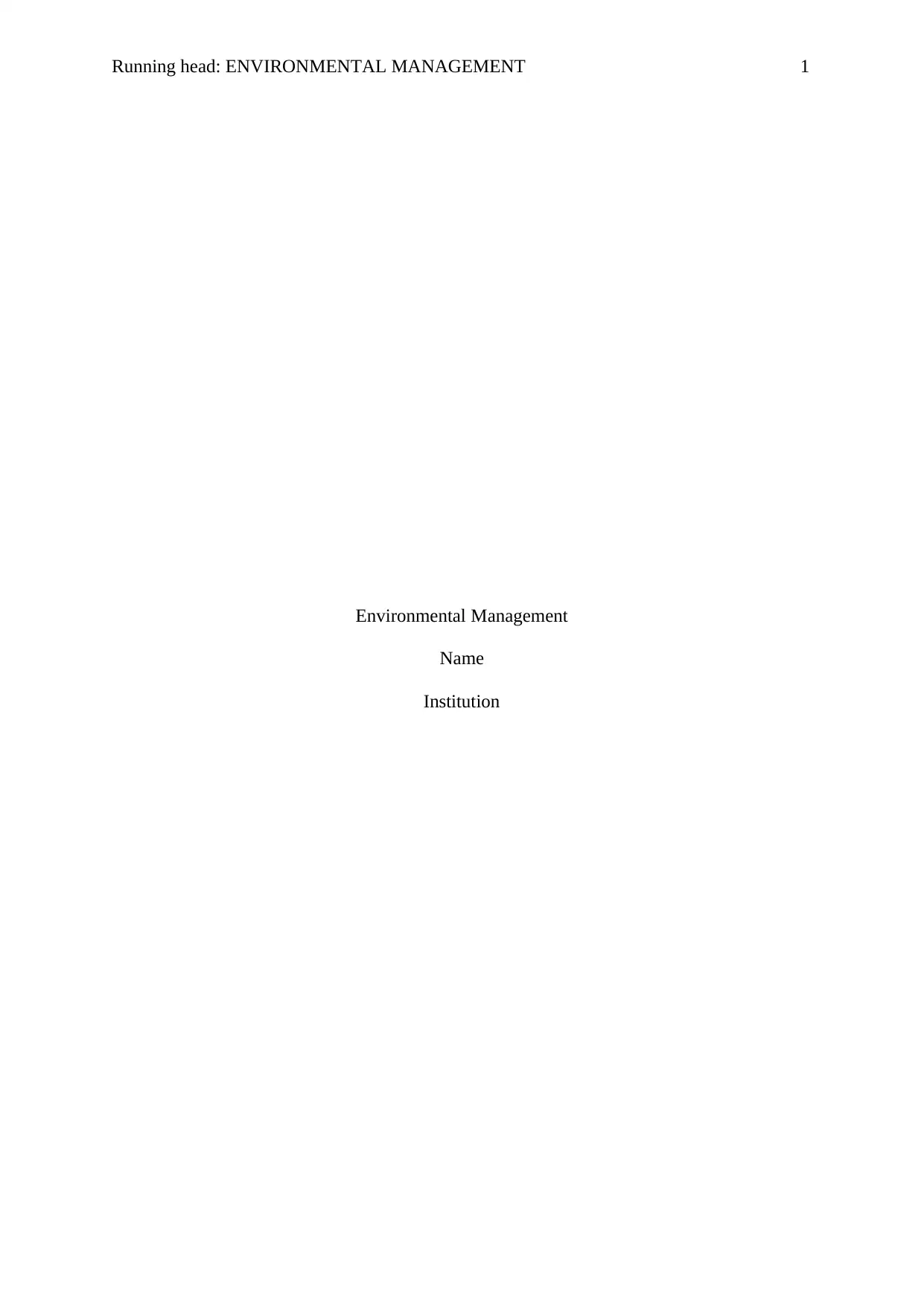
Running head: ENVIRONMENTAL MANAGEMENT 1
Environmental Management
Name
Institution
Environmental Management
Name
Institution
Paraphrase This Document
Need a fresh take? Get an instant paraphrase of this document with our AI Paraphraser
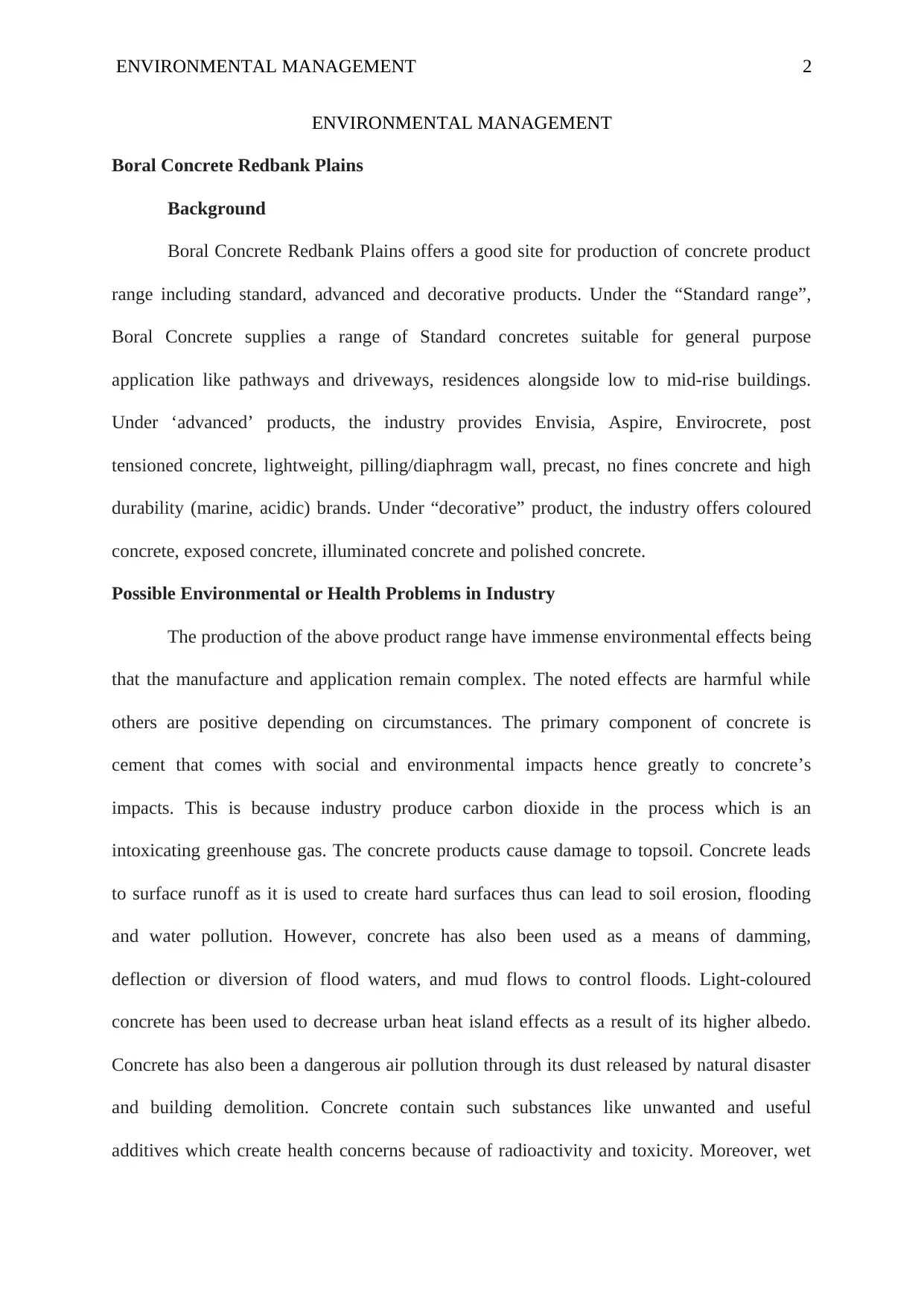
ENVIRONMENTAL MANAGEMENT 2
ENVIRONMENTAL MANAGEMENT
Boral Concrete Redbank Plains
Background
Boral Concrete Redbank Plains offers a good site for production of concrete product
range including standard, advanced and decorative products. Under the “Standard range”,
Boral Concrete supplies a range of Standard concretes suitable for general purpose
application like pathways and driveways, residences alongside low to mid-rise buildings.
Under ‘advanced’ products, the industry provides Envisia, Aspire, Envirocrete, post
tensioned concrete, lightweight, pilling/diaphragm wall, precast, no fines concrete and high
durability (marine, acidic) brands. Under “decorative” product, the industry offers coloured
concrete, exposed concrete, illuminated concrete and polished concrete.
Possible Environmental or Health Problems in Industry
The production of the above product range have immense environmental effects being
that the manufacture and application remain complex. The noted effects are harmful while
others are positive depending on circumstances. The primary component of concrete is
cement that comes with social and environmental impacts hence greatly to concrete’s
impacts. This is because industry produce carbon dioxide in the process which is an
intoxicating greenhouse gas. The concrete products cause damage to topsoil. Concrete leads
to surface runoff as it is used to create hard surfaces thus can lead to soil erosion, flooding
and water pollution. However, concrete has also been used as a means of damming,
deflection or diversion of flood waters, and mud flows to control floods. Light-coloured
concrete has been used to decrease urban heat island effects as a result of its higher albedo.
Concrete has also been a dangerous air pollution through its dust released by natural disaster
and building demolition. Concrete contain such substances like unwanted and useful
additives which create health concerns because of radioactivity and toxicity. Moreover, wet
ENVIRONMENTAL MANAGEMENT
Boral Concrete Redbank Plains
Background
Boral Concrete Redbank Plains offers a good site for production of concrete product
range including standard, advanced and decorative products. Under the “Standard range”,
Boral Concrete supplies a range of Standard concretes suitable for general purpose
application like pathways and driveways, residences alongside low to mid-rise buildings.
Under ‘advanced’ products, the industry provides Envisia, Aspire, Envirocrete, post
tensioned concrete, lightweight, pilling/diaphragm wall, precast, no fines concrete and high
durability (marine, acidic) brands. Under “decorative” product, the industry offers coloured
concrete, exposed concrete, illuminated concrete and polished concrete.
Possible Environmental or Health Problems in Industry
The production of the above product range have immense environmental effects being
that the manufacture and application remain complex. The noted effects are harmful while
others are positive depending on circumstances. The primary component of concrete is
cement that comes with social and environmental impacts hence greatly to concrete’s
impacts. This is because industry produce carbon dioxide in the process which is an
intoxicating greenhouse gas. The concrete products cause damage to topsoil. Concrete leads
to surface runoff as it is used to create hard surfaces thus can lead to soil erosion, flooding
and water pollution. However, concrete has also been used as a means of damming,
deflection or diversion of flood waters, and mud flows to control floods. Light-coloured
concrete has been used to decrease urban heat island effects as a result of its higher albedo.
Concrete has also been a dangerous air pollution through its dust released by natural disaster
and building demolition. Concrete contain such substances like unwanted and useful
additives which create health concerns because of radioactivity and toxicity. Moreover, wet
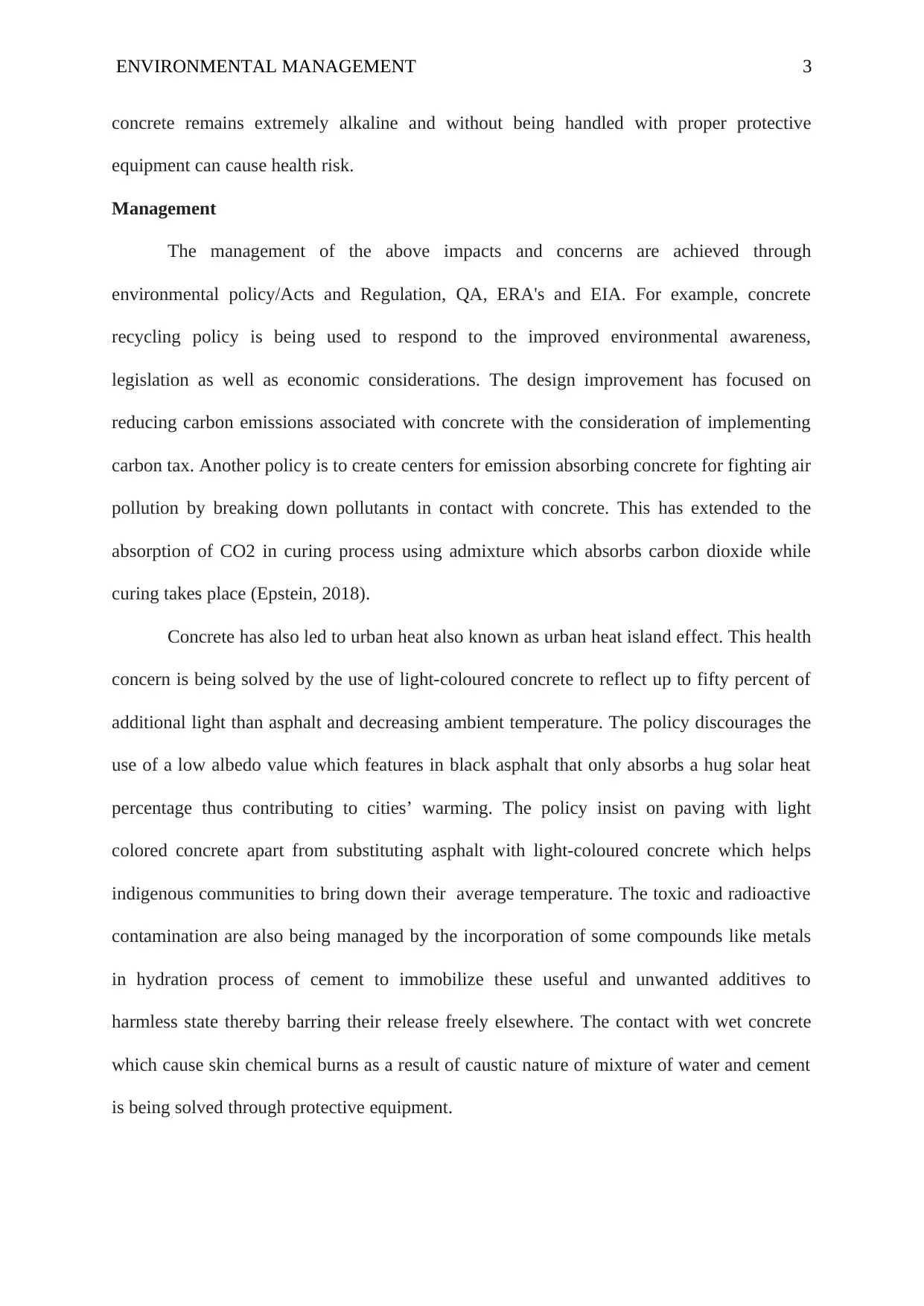
ENVIRONMENTAL MANAGEMENT 3
concrete remains extremely alkaline and without being handled with proper protective
equipment can cause health risk.
Management
The management of the above impacts and concerns are achieved through
environmental policy/Acts and Regulation, QA, ERA's and EIA. For example, concrete
recycling policy is being used to respond to the improved environmental awareness,
legislation as well as economic considerations. The design improvement has focused on
reducing carbon emissions associated with concrete with the consideration of implementing
carbon tax. Another policy is to create centers for emission absorbing concrete for fighting air
pollution by breaking down pollutants in contact with concrete. This has extended to the
absorption of CO2 in curing process using admixture which absorbs carbon dioxide while
curing takes place (Epstein, 2018).
Concrete has also led to urban heat also known as urban heat island effect. This health
concern is being solved by the use of light-coloured concrete to reflect up to fifty percent of
additional light than asphalt and decreasing ambient temperature. The policy discourages the
use of a low albedo value which features in black asphalt that only absorbs a hug solar heat
percentage thus contributing to cities’ warming. The policy insist on paving with light
colored concrete apart from substituting asphalt with light-coloured concrete which helps
indigenous communities to bring down their average temperature. The toxic and radioactive
contamination are also being managed by the incorporation of some compounds like metals
in hydration process of cement to immobilize these useful and unwanted additives to
harmless state thereby barring their release freely elsewhere. The contact with wet concrete
which cause skin chemical burns as a result of caustic nature of mixture of water and cement
is being solved through protective equipment.
concrete remains extremely alkaline and without being handled with proper protective
equipment can cause health risk.
Management
The management of the above impacts and concerns are achieved through
environmental policy/Acts and Regulation, QA, ERA's and EIA. For example, concrete
recycling policy is being used to respond to the improved environmental awareness,
legislation as well as economic considerations. The design improvement has focused on
reducing carbon emissions associated with concrete with the consideration of implementing
carbon tax. Another policy is to create centers for emission absorbing concrete for fighting air
pollution by breaking down pollutants in contact with concrete. This has extended to the
absorption of CO2 in curing process using admixture which absorbs carbon dioxide while
curing takes place (Epstein, 2018).
Concrete has also led to urban heat also known as urban heat island effect. This health
concern is being solved by the use of light-coloured concrete to reflect up to fifty percent of
additional light than asphalt and decreasing ambient temperature. The policy discourages the
use of a low albedo value which features in black asphalt that only absorbs a hug solar heat
percentage thus contributing to cities’ warming. The policy insist on paving with light
colored concrete apart from substituting asphalt with light-coloured concrete which helps
indigenous communities to bring down their average temperature. The toxic and radioactive
contamination are also being managed by the incorporation of some compounds like metals
in hydration process of cement to immobilize these useful and unwanted additives to
harmless state thereby barring their release freely elsewhere. The contact with wet concrete
which cause skin chemical burns as a result of caustic nature of mixture of water and cement
is being solved through protective equipment.
⊘ This is a preview!⊘
Do you want full access?
Subscribe today to unlock all pages.

Trusted by 1+ million students worldwide
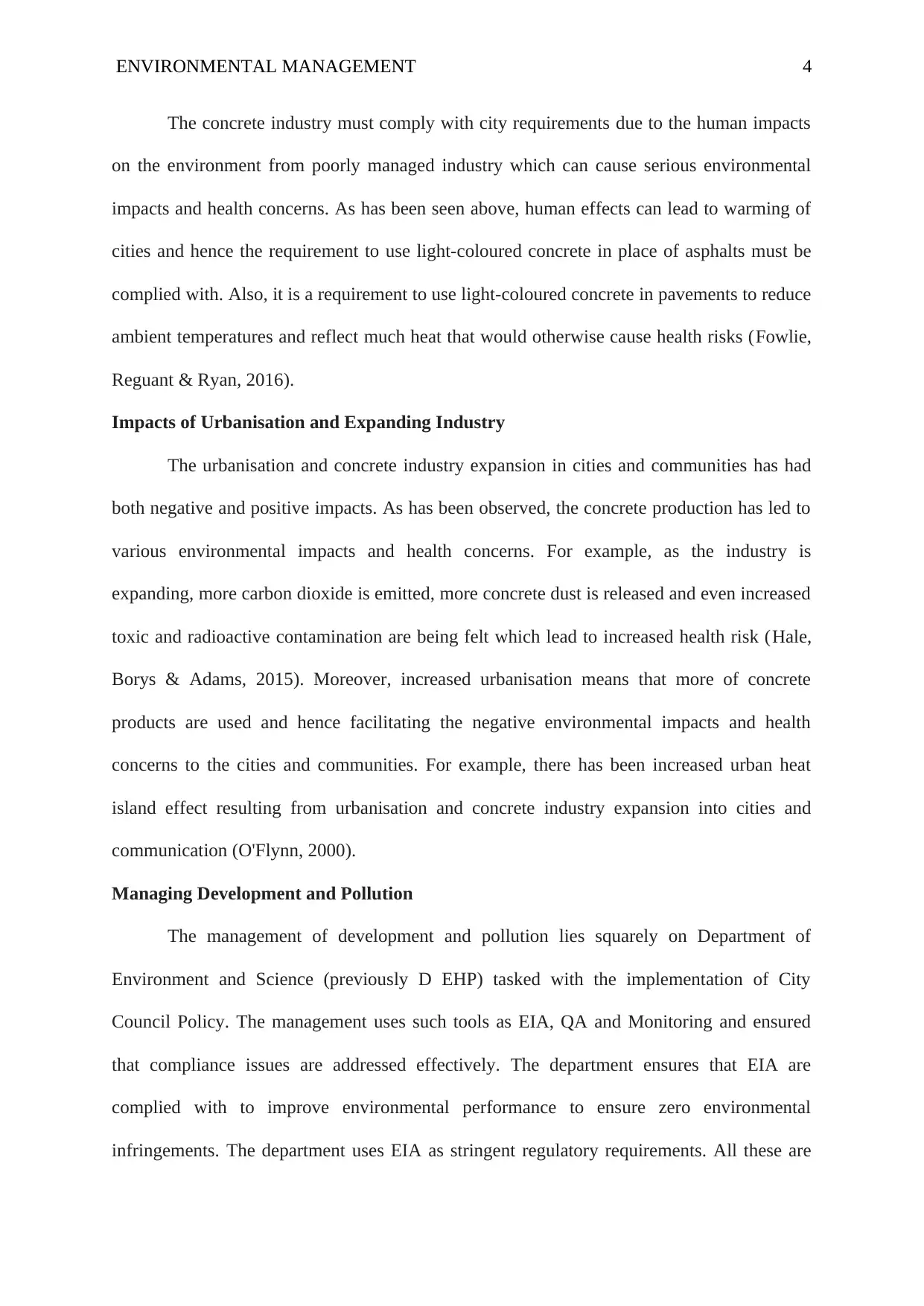
ENVIRONMENTAL MANAGEMENT 4
The concrete industry must comply with city requirements due to the human impacts
on the environment from poorly managed industry which can cause serious environmental
impacts and health concerns. As has been seen above, human effects can lead to warming of
cities and hence the requirement to use light-coloured concrete in place of asphalts must be
complied with. Also, it is a requirement to use light-coloured concrete in pavements to reduce
ambient temperatures and reflect much heat that would otherwise cause health risks (Fowlie,
Reguant & Ryan, 2016).
Impacts of Urbanisation and Expanding Industry
The urbanisation and concrete industry expansion in cities and communities has had
both negative and positive impacts. As has been observed, the concrete production has led to
various environmental impacts and health concerns. For example, as the industry is
expanding, more carbon dioxide is emitted, more concrete dust is released and even increased
toxic and radioactive contamination are being felt which lead to increased health risk (Hale,
Borys & Adams, 2015). Moreover, increased urbanisation means that more of concrete
products are used and hence facilitating the negative environmental impacts and health
concerns to the cities and communities. For example, there has been increased urban heat
island effect resulting from urbanisation and concrete industry expansion into cities and
communication (O'Flynn, 2000).
Managing Development and Pollution
The management of development and pollution lies squarely on Department of
Environment and Science (previously D EHP) tasked with the implementation of City
Council Policy. The management uses such tools as EIA, QA and Monitoring and ensured
that compliance issues are addressed effectively. The department ensures that EIA are
complied with to improve environmental performance to ensure zero environmental
infringements. The department uses EIA as stringent regulatory requirements. All these are
The concrete industry must comply with city requirements due to the human impacts
on the environment from poorly managed industry which can cause serious environmental
impacts and health concerns. As has been seen above, human effects can lead to warming of
cities and hence the requirement to use light-coloured concrete in place of asphalts must be
complied with. Also, it is a requirement to use light-coloured concrete in pavements to reduce
ambient temperatures and reflect much heat that would otherwise cause health risks (Fowlie,
Reguant & Ryan, 2016).
Impacts of Urbanisation and Expanding Industry
The urbanisation and concrete industry expansion in cities and communities has had
both negative and positive impacts. As has been observed, the concrete production has led to
various environmental impacts and health concerns. For example, as the industry is
expanding, more carbon dioxide is emitted, more concrete dust is released and even increased
toxic and radioactive contamination are being felt which lead to increased health risk (Hale,
Borys & Adams, 2015). Moreover, increased urbanisation means that more of concrete
products are used and hence facilitating the negative environmental impacts and health
concerns to the cities and communities. For example, there has been increased urban heat
island effect resulting from urbanisation and concrete industry expansion into cities and
communication (O'Flynn, 2000).
Managing Development and Pollution
The management of development and pollution lies squarely on Department of
Environment and Science (previously D EHP) tasked with the implementation of City
Council Policy. The management uses such tools as EIA, QA and Monitoring and ensured
that compliance issues are addressed effectively. The department ensures that EIA are
complied with to improve environmental performance to ensure zero environmental
infringements. The department uses EIA as stringent regulatory requirements. All these are
Paraphrase This Document
Need a fresh take? Get an instant paraphrase of this document with our AI Paraphraser
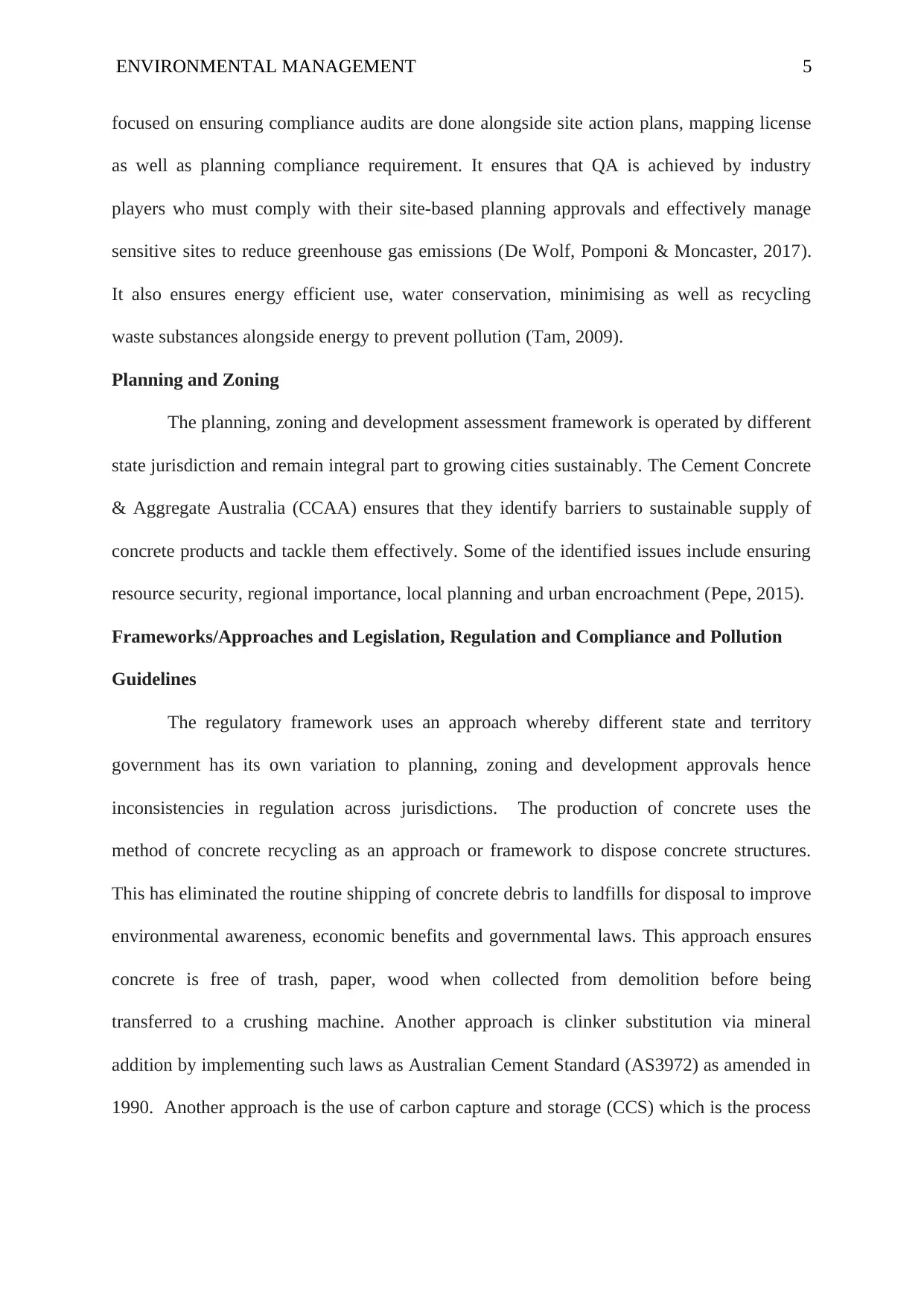
ENVIRONMENTAL MANAGEMENT 5
focused on ensuring compliance audits are done alongside site action plans, mapping license
as well as planning compliance requirement. It ensures that QA is achieved by industry
players who must comply with their site-based planning approvals and effectively manage
sensitive sites to reduce greenhouse gas emissions (De Wolf, Pomponi & Moncaster, 2017).
It also ensures energy efficient use, water conservation, minimising as well as recycling
waste substances alongside energy to prevent pollution (Tam, 2009).
Planning and Zoning
The planning, zoning and development assessment framework is operated by different
state jurisdiction and remain integral part to growing cities sustainably. The Cement Concrete
& Aggregate Australia (CCAA) ensures that they identify barriers to sustainable supply of
concrete products and tackle them effectively. Some of the identified issues include ensuring
resource security, regional importance, local planning and urban encroachment (Pepe, 2015).
Frameworks/Approaches and Legislation, Regulation and Compliance and Pollution
Guidelines
The regulatory framework uses an approach whereby different state and territory
government has its own variation to planning, zoning and development approvals hence
inconsistencies in regulation across jurisdictions. The production of concrete uses the
method of concrete recycling as an approach or framework to dispose concrete structures.
This has eliminated the routine shipping of concrete debris to landfills for disposal to improve
environmental awareness, economic benefits and governmental laws. This approach ensures
concrete is free of trash, paper, wood when collected from demolition before being
transferred to a crushing machine. Another approach is clinker substitution via mineral
addition by implementing such laws as Australian Cement Standard (AS3972) as amended in
1990. Another approach is the use of carbon capture and storage (CCS) which is the process
focused on ensuring compliance audits are done alongside site action plans, mapping license
as well as planning compliance requirement. It ensures that QA is achieved by industry
players who must comply with their site-based planning approvals and effectively manage
sensitive sites to reduce greenhouse gas emissions (De Wolf, Pomponi & Moncaster, 2017).
It also ensures energy efficient use, water conservation, minimising as well as recycling
waste substances alongside energy to prevent pollution (Tam, 2009).
Planning and Zoning
The planning, zoning and development assessment framework is operated by different
state jurisdiction and remain integral part to growing cities sustainably. The Cement Concrete
& Aggregate Australia (CCAA) ensures that they identify barriers to sustainable supply of
concrete products and tackle them effectively. Some of the identified issues include ensuring
resource security, regional importance, local planning and urban encroachment (Pepe, 2015).
Frameworks/Approaches and Legislation, Regulation and Compliance and Pollution
Guidelines
The regulatory framework uses an approach whereby different state and territory
government has its own variation to planning, zoning and development approvals hence
inconsistencies in regulation across jurisdictions. The production of concrete uses the
method of concrete recycling as an approach or framework to dispose concrete structures.
This has eliminated the routine shipping of concrete debris to landfills for disposal to improve
environmental awareness, economic benefits and governmental laws. This approach ensures
concrete is free of trash, paper, wood when collected from demolition before being
transferred to a crushing machine. Another approach is clinker substitution via mineral
addition by implementing such laws as Australian Cement Standard (AS3972) as amended in
1990. Another approach is the use of carbon capture and storage (CCS) which is the process
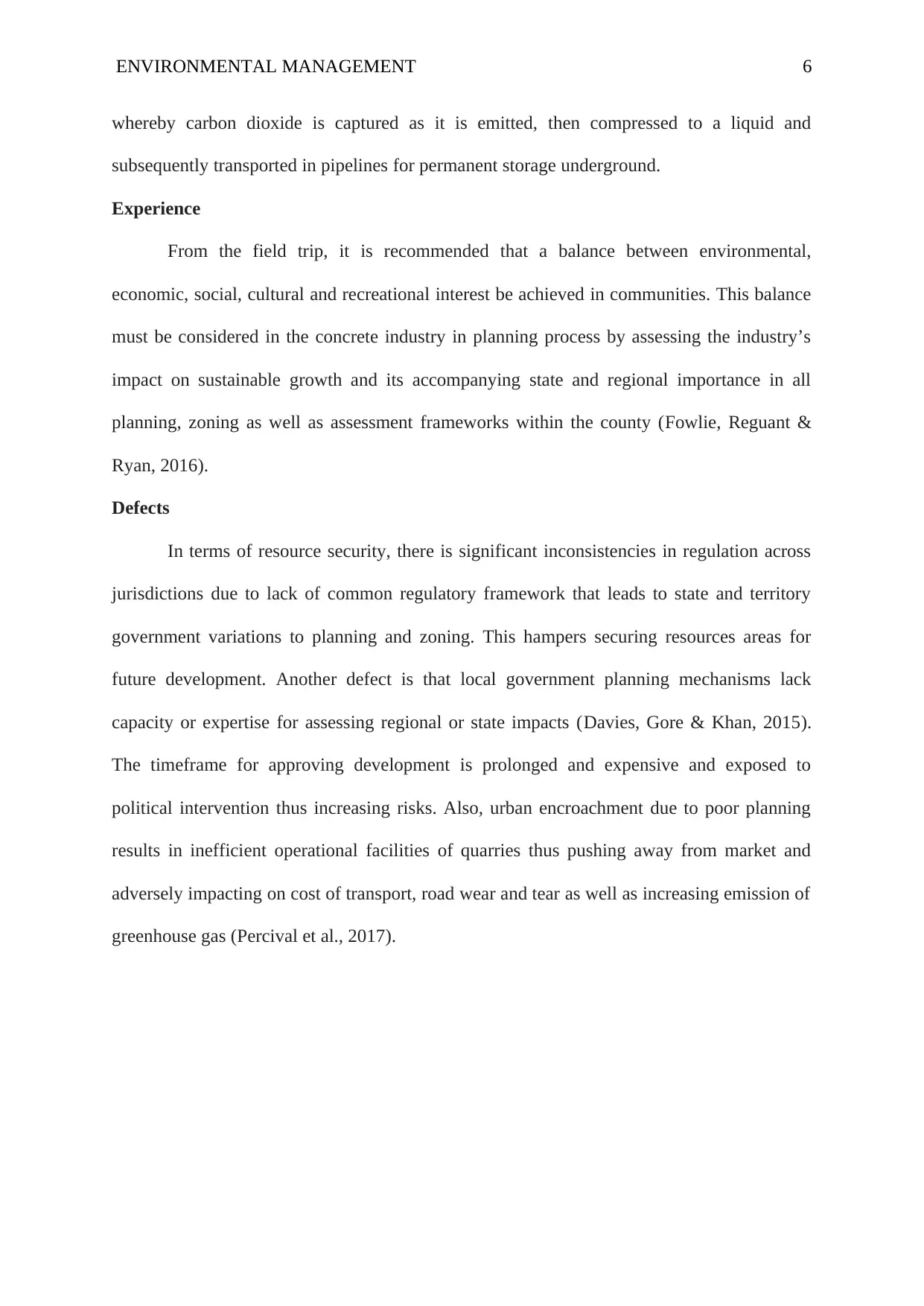
ENVIRONMENTAL MANAGEMENT 6
whereby carbon dioxide is captured as it is emitted, then compressed to a liquid and
subsequently transported in pipelines for permanent storage underground.
Experience
From the field trip, it is recommended that a balance between environmental,
economic, social, cultural and recreational interest be achieved in communities. This balance
must be considered in the concrete industry in planning process by assessing the industry’s
impact on sustainable growth and its accompanying state and regional importance in all
planning, zoning as well as assessment frameworks within the county (Fowlie, Reguant &
Ryan, 2016).
Defects
In terms of resource security, there is significant inconsistencies in regulation across
jurisdictions due to lack of common regulatory framework that leads to state and territory
government variations to planning and zoning. This hampers securing resources areas for
future development. Another defect is that local government planning mechanisms lack
capacity or expertise for assessing regional or state impacts (Davies, Gore & Khan, 2015).
The timeframe for approving development is prolonged and expensive and exposed to
political intervention thus increasing risks. Also, urban encroachment due to poor planning
results in inefficient operational facilities of quarries thus pushing away from market and
adversely impacting on cost of transport, road wear and tear as well as increasing emission of
greenhouse gas (Percival et al., 2017).
whereby carbon dioxide is captured as it is emitted, then compressed to a liquid and
subsequently transported in pipelines for permanent storage underground.
Experience
From the field trip, it is recommended that a balance between environmental,
economic, social, cultural and recreational interest be achieved in communities. This balance
must be considered in the concrete industry in planning process by assessing the industry’s
impact on sustainable growth and its accompanying state and regional importance in all
planning, zoning as well as assessment frameworks within the county (Fowlie, Reguant &
Ryan, 2016).
Defects
In terms of resource security, there is significant inconsistencies in regulation across
jurisdictions due to lack of common regulatory framework that leads to state and territory
government variations to planning and zoning. This hampers securing resources areas for
future development. Another defect is that local government planning mechanisms lack
capacity or expertise for assessing regional or state impacts (Davies, Gore & Khan, 2015).
The timeframe for approving development is prolonged and expensive and exposed to
political intervention thus increasing risks. Also, urban encroachment due to poor planning
results in inefficient operational facilities of quarries thus pushing away from market and
adversely impacting on cost of transport, road wear and tear as well as increasing emission of
greenhouse gas (Percival et al., 2017).
⊘ This is a preview!⊘
Do you want full access?
Subscribe today to unlock all pages.

Trusted by 1+ million students worldwide
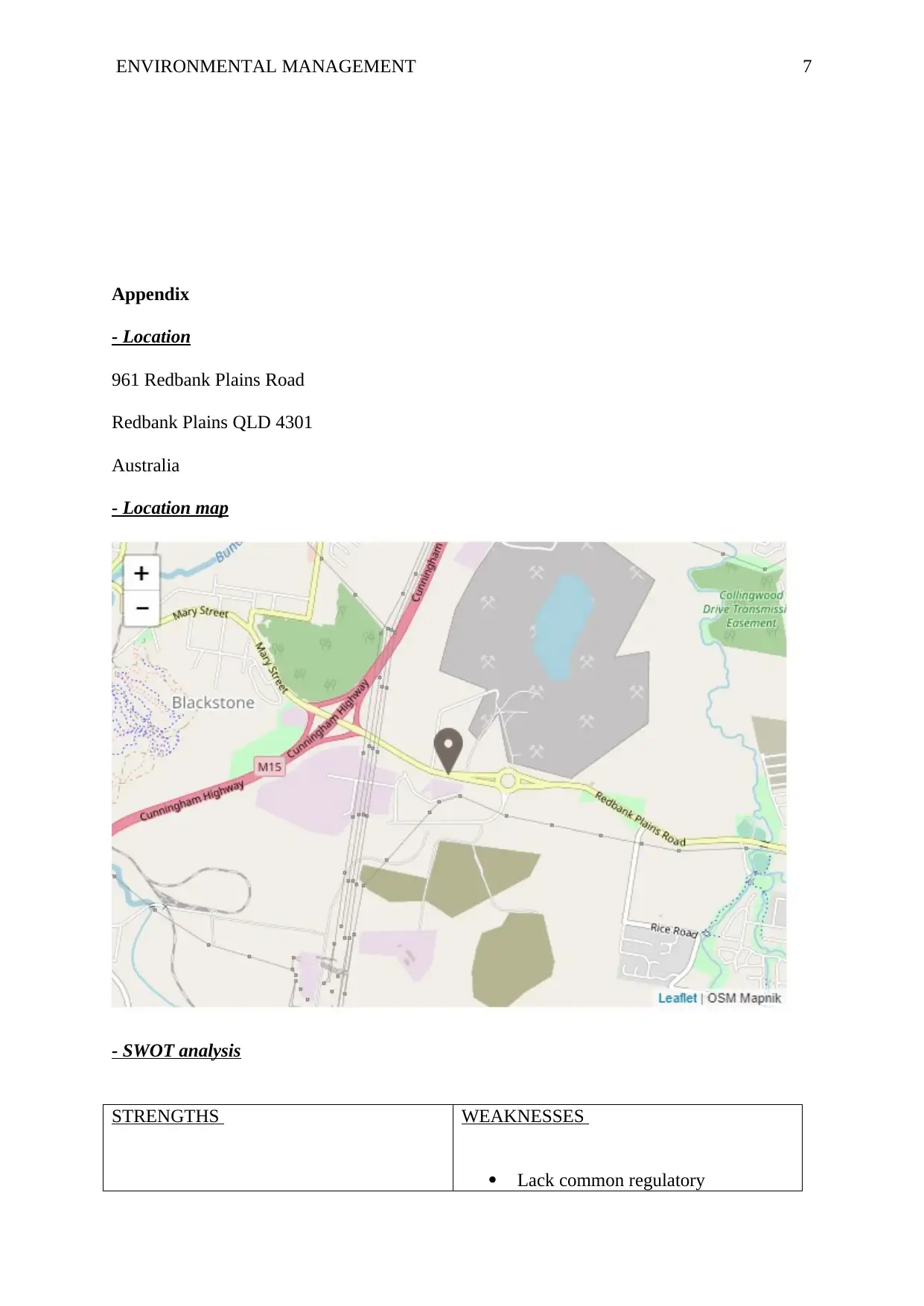
ENVIRONMENTAL MANAGEMENT 7
Appendix
- Location
961 Redbank Plains Road
Redbank Plains QLD 4301
Australia
- Location map
- SWOT analysis
STRENGTHS WEAKNESSES
Lack common regulatory
Appendix
- Location
961 Redbank Plains Road
Redbank Plains QLD 4301
Australia
- Location map
- SWOT analysis
STRENGTHS WEAKNESSES
Lack common regulatory
Paraphrase This Document
Need a fresh take? Get an instant paraphrase of this document with our AI Paraphraser
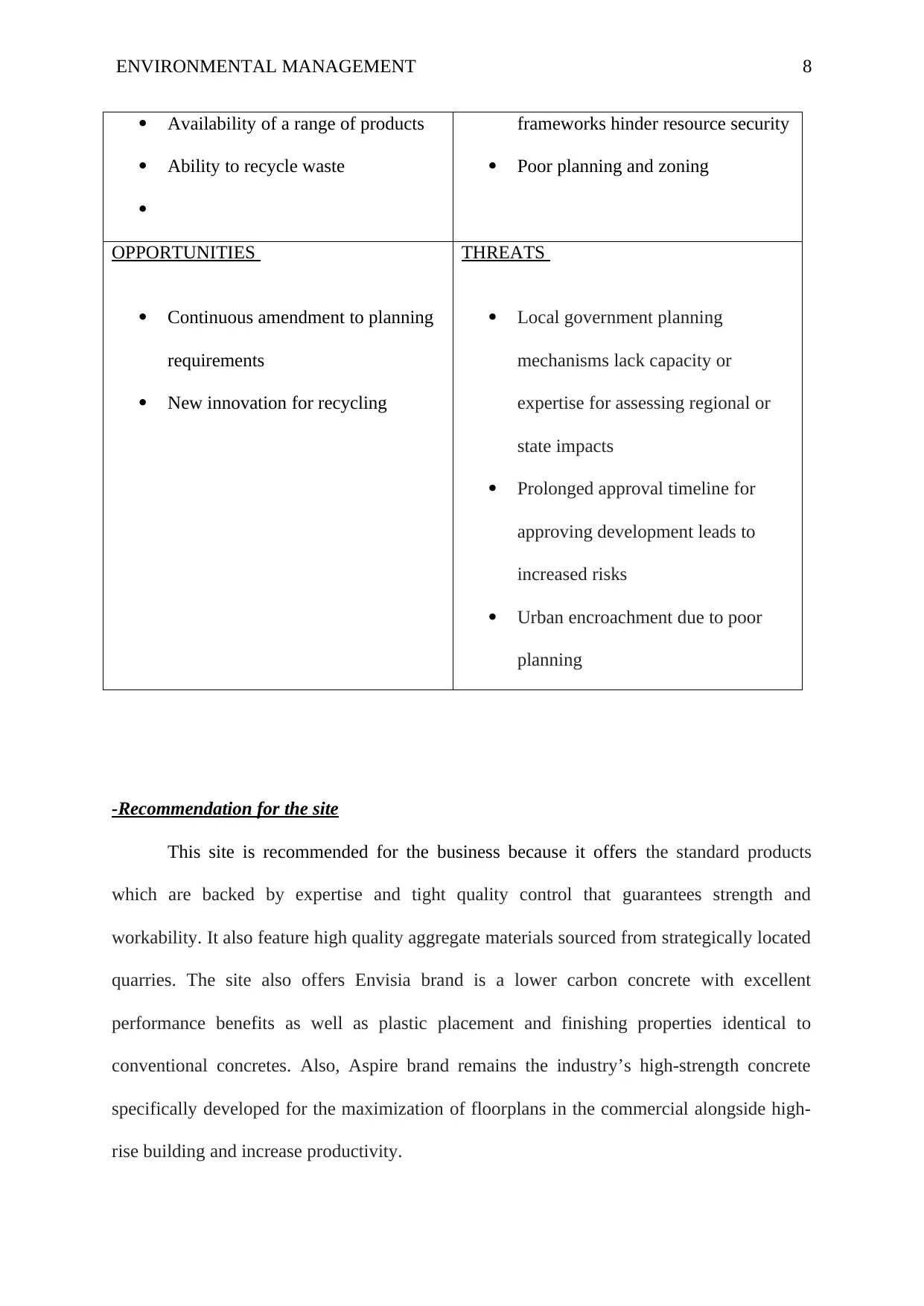
ENVIRONMENTAL MANAGEMENT 8
Availability of a range of products
Ability to recycle waste
frameworks hinder resource security
Poor planning and zoning
OPPORTUNITIES
Continuous amendment to planning
requirements
New innovation for recycling
THREATS
Local government planning
mechanisms lack capacity or
expertise for assessing regional or
state impacts
Prolonged approval timeline for
approving development leads to
increased risks
Urban encroachment due to poor
planning
-Recommendation for the site
This site is recommended for the business because it offers the standard products
which are backed by expertise and tight quality control that guarantees strength and
workability. It also feature high quality aggregate materials sourced from strategically located
quarries. The site also offers Envisia brand is a lower carbon concrete with excellent
performance benefits as well as plastic placement and finishing properties identical to
conventional concretes. Also, Aspire brand remains the industry’s high-strength concrete
specifically developed for the maximization of floorplans in the commercial alongside high-
rise building and increase productivity.
Availability of a range of products
Ability to recycle waste
frameworks hinder resource security
Poor planning and zoning
OPPORTUNITIES
Continuous amendment to planning
requirements
New innovation for recycling
THREATS
Local government planning
mechanisms lack capacity or
expertise for assessing regional or
state impacts
Prolonged approval timeline for
approving development leads to
increased risks
Urban encroachment due to poor
planning
-Recommendation for the site
This site is recommended for the business because it offers the standard products
which are backed by expertise and tight quality control that guarantees strength and
workability. It also feature high quality aggregate materials sourced from strategically located
quarries. The site also offers Envisia brand is a lower carbon concrete with excellent
performance benefits as well as plastic placement and finishing properties identical to
conventional concretes. Also, Aspire brand remains the industry’s high-strength concrete
specifically developed for the maximization of floorplans in the commercial alongside high-
rise building and increase productivity.
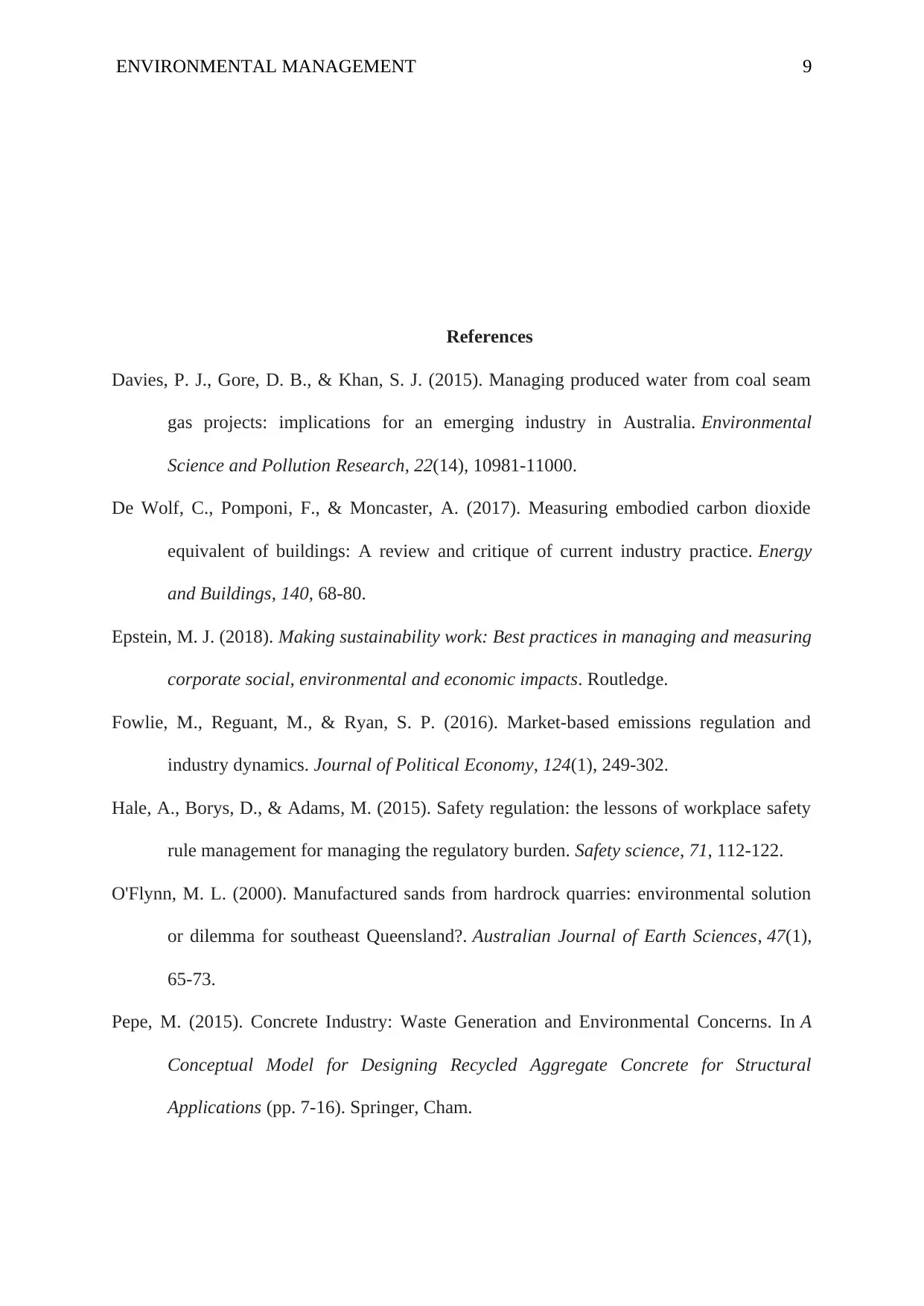
ENVIRONMENTAL MANAGEMENT 9
References
Davies, P. J., Gore, D. B., & Khan, S. J. (2015). Managing produced water from coal seam
gas projects: implications for an emerging industry in Australia. Environmental
Science and Pollution Research, 22(14), 10981-11000.
De Wolf, C., Pomponi, F., & Moncaster, A. (2017). Measuring embodied carbon dioxide
equivalent of buildings: A review and critique of current industry practice. Energy
and Buildings, 140, 68-80.
Epstein, M. J. (2018). Making sustainability work: Best practices in managing and measuring
corporate social, environmental and economic impacts. Routledge.
Fowlie, M., Reguant, M., & Ryan, S. P. (2016). Market-based emissions regulation and
industry dynamics. Journal of Political Economy, 124(1), 249-302.
Hale, A., Borys, D., & Adams, M. (2015). Safety regulation: the lessons of workplace safety
rule management for managing the regulatory burden. Safety science, 71, 112-122.
O'Flynn, M. L. (2000). Manufactured sands from hardrock quarries: environmental solution
or dilemma for southeast Queensland?. Australian Journal of Earth Sciences, 47(1),
65-73.
Pepe, M. (2015). Concrete Industry: Waste Generation and Environmental Concerns. In A
Conceptual Model for Designing Recycled Aggregate Concrete for Structural
Applications (pp. 7-16). Springer, Cham.
References
Davies, P. J., Gore, D. B., & Khan, S. J. (2015). Managing produced water from coal seam
gas projects: implications for an emerging industry in Australia. Environmental
Science and Pollution Research, 22(14), 10981-11000.
De Wolf, C., Pomponi, F., & Moncaster, A. (2017). Measuring embodied carbon dioxide
equivalent of buildings: A review and critique of current industry practice. Energy
and Buildings, 140, 68-80.
Epstein, M. J. (2018). Making sustainability work: Best practices in managing and measuring
corporate social, environmental and economic impacts. Routledge.
Fowlie, M., Reguant, M., & Ryan, S. P. (2016). Market-based emissions regulation and
industry dynamics. Journal of Political Economy, 124(1), 249-302.
Hale, A., Borys, D., & Adams, M. (2015). Safety regulation: the lessons of workplace safety
rule management for managing the regulatory burden. Safety science, 71, 112-122.
O'Flynn, M. L. (2000). Manufactured sands from hardrock quarries: environmental solution
or dilemma for southeast Queensland?. Australian Journal of Earth Sciences, 47(1),
65-73.
Pepe, M. (2015). Concrete Industry: Waste Generation and Environmental Concerns. In A
Conceptual Model for Designing Recycled Aggregate Concrete for Structural
Applications (pp. 7-16). Springer, Cham.
⊘ This is a preview!⊘
Do you want full access?
Subscribe today to unlock all pages.

Trusted by 1+ million students worldwide
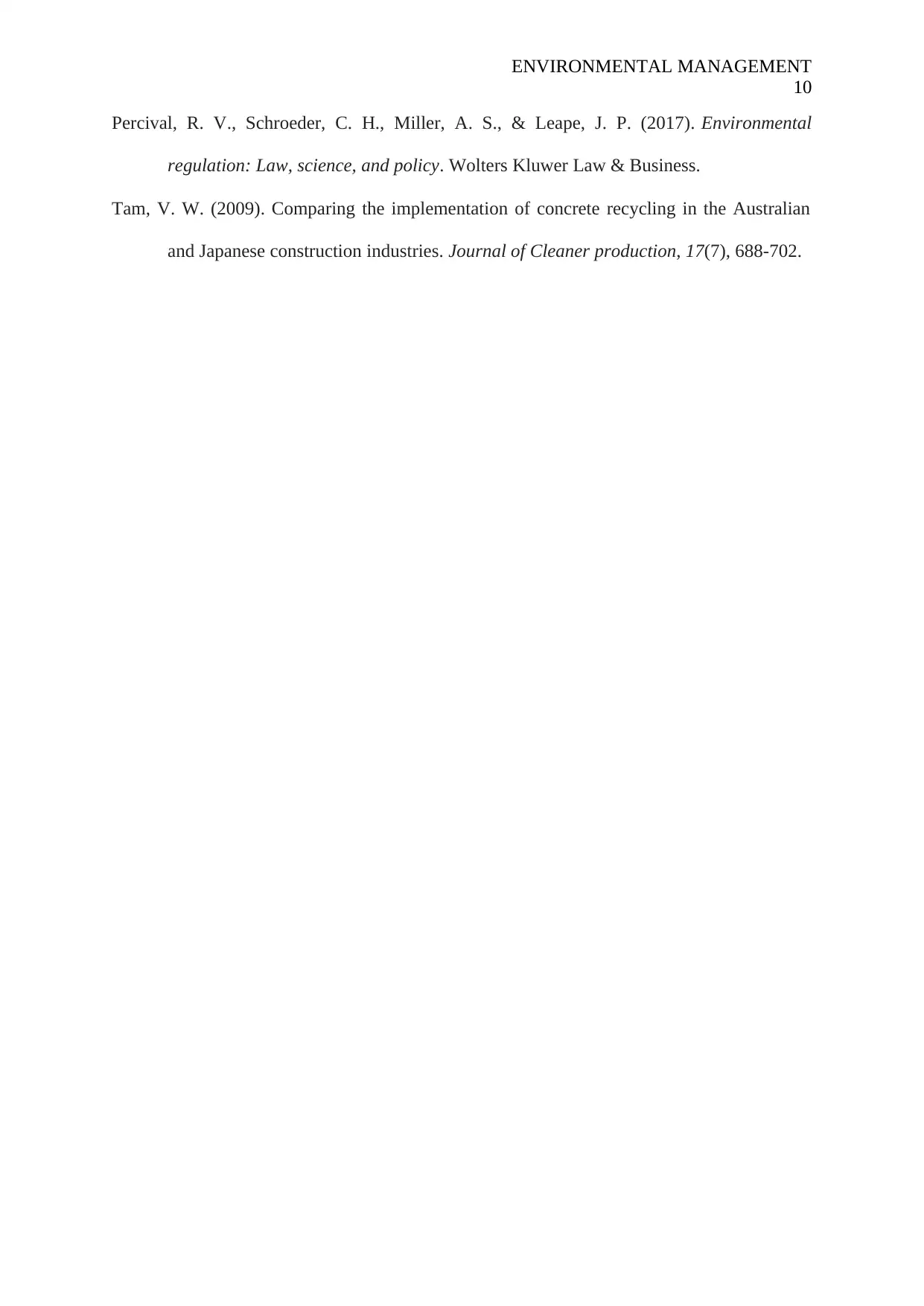
ENVIRONMENTAL MANAGEMENT
10
Percival, R. V., Schroeder, C. H., Miller, A. S., & Leape, J. P. (2017). Environmental
regulation: Law, science, and policy. Wolters Kluwer Law & Business.
Tam, V. W. (2009). Comparing the implementation of concrete recycling in the Australian
and Japanese construction industries. Journal of Cleaner production, 17(7), 688-702.
10
Percival, R. V., Schroeder, C. H., Miller, A. S., & Leape, J. P. (2017). Environmental
regulation: Law, science, and policy. Wolters Kluwer Law & Business.
Tam, V. W. (2009). Comparing the implementation of concrete recycling in the Australian
and Japanese construction industries. Journal of Cleaner production, 17(7), 688-702.
1 out of 10
Your All-in-One AI-Powered Toolkit for Academic Success.
+13062052269
info@desklib.com
Available 24*7 on WhatsApp / Email
![[object Object]](/_next/static/media/star-bottom.7253800d.svg)
Unlock your academic potential
Copyright © 2020–2025 A2Z Services. All Rights Reserved. Developed and managed by ZUCOL.